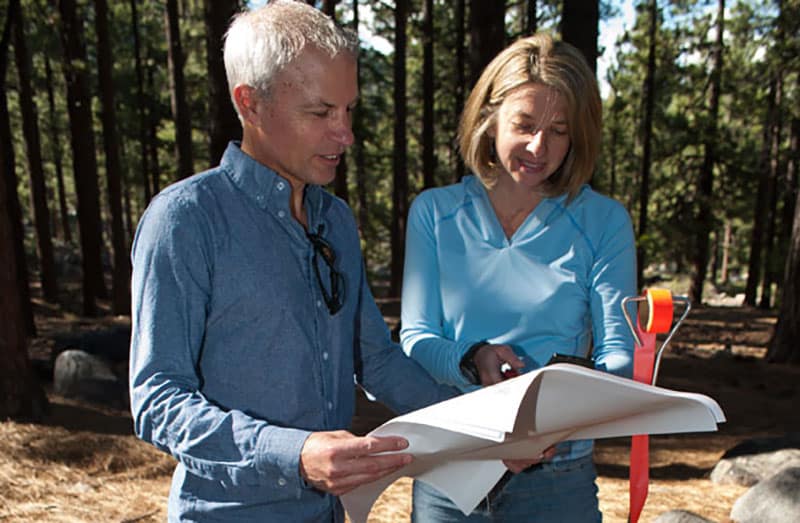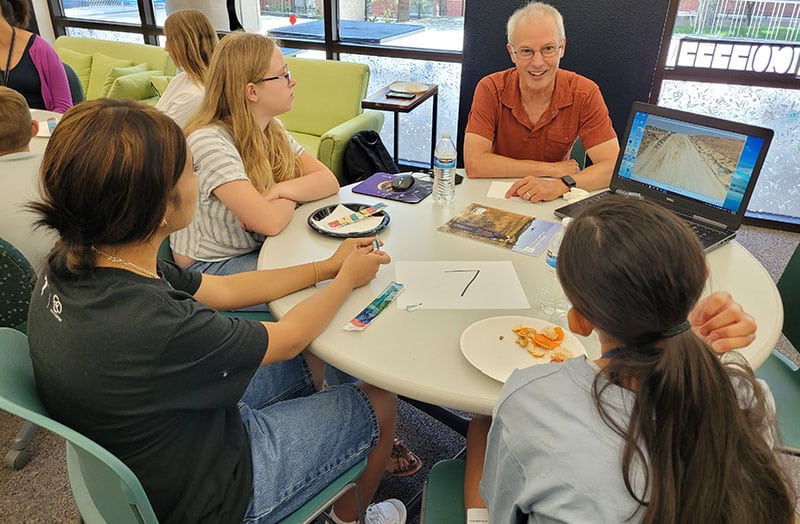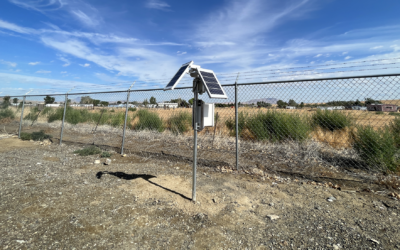Tim Minor: Celebrating a Career in GIS and Remote Sensing
DECEMBER 21, 2022
RENO, NEV.
By Elyse DeFranco
Tim Minor
GIS
Remote Sensing
Above: Minor piloting a drone; he is a FAA-certified Remote Pilot in Command.
Credit: Tim Minor/DRI.
Tim Minor, M.A, recently retired from DRI after 31 years. His successful career as a geographic information systems (GIS) and remote sensing scientist brought him to DRI in 1991; he served as Deputy Director of DEES from 2012 to 2018, and Interim Executive Division Director of DEES from 2018 to 2021.
Minor’s work uses satellite and drone imagery to map and analyze invasive species, surface disturbance, ground water resources, and mountain watershed water quality, among many other applications. He is a FAA-certified Remote Pilot in Command, and he taught introductory and advanced courses in GIS applications and image processing methods.
DRI sat down with Minor to discuss his long career as a scientist and competitive runner, his career highlights (featuring a Ghanaian marathon), and his advice for young scientists (including his own son, Blake, an associate research scientist in DHS).

Minor conducting field work with DRI biologist Mary Cablk, whom he frequently worked alongside.
Credit: Tim Minor/DRI.
DRI: What first brought you to DRI?
Minor: Well, I grew up in Pacific Grove, California, and went to Monterey Peninsula College, and then got a scholarship to come to the University of Nevada. I only stayed two years, finished off my degree and went back to grad school at U.C. Santa Barbara. I got an offer to come up to Reno in 1989 to work for a mining company that needed a geologic remote sensing person. While I was working for them, I started meeting some people from DRI, and I just thought it was an amazing place.
There was a guy named Jonathan Davis who was a mentor of mine. He was one of my teachers at UNR and I was really looking forward to working with him, Dave Mouat, and some of the other amazing people at DRI. I didn’t know quite how that would work, but things just kind of fell in place. I got a job at DRI in 1991.
The sad part was that I was really looking forward to working with Jonathan Davis — his wife worked with me at my mining company — but they were involved in a horrible car accident a couple of months before I got to DRI; Jonathan was tragically killed. We have a Jonathan Davis scholarship in DEES in his name.
DRI: And you’ve been at DRI ever since?
Minor: Yep, I stayed at DRI for 31 years. I think one of the things that really helped me is that in the GIS/remote sensing field, there are opportunities to work on a lot of diverse projects. I started off working on an air quality project, and then I started doing a lot of stuff with water, biology, and vegetation. And it just kind of took off from there — it was very rewarding.
You know, I have a master’s degree, not a Ph.D. So, despite everyone calling me doctor all these years, I’m not. What I hope to have inspired here is that with your master’s, you can still go pretty far at DRI. I’m pretty proud of the fact that I became a director with a master’s.
I never really felt a ton of pressure to get my PhD. I was also still competing a lot – I was still running very seriously in the 90s and into the 2000s, so I had to make some choices. And I chose to continue to be a runner and have a career on that side instead of going after the Ph.D.

A newspaper clipping from the Reno-Gazette Journal that covered Minor’s 1993 marathon race in Ghana. Minor finished in 9th place with only 3 hours of sleep in the preceding two days due to traveling.
Credit: Tim Minor/DRI.
DRI: Tell me more about your competitive running career.
Minor: I ran competitively for a long time, from the time I was 15 to age 51. I ran for Nevada as an undergrad and then I just kept going.
DRI: What inspired you to become a specialist in remote sensing?
Minor: I’ve always been a map freak. I think since I was four or five years old, I was the geeky kid in the back of the car telling my mom and dad where to go because I was looking at maps. I was just fascinated by spatial relationships. People talk about cognitive mapping and our brains and I just always loved thinking about, “Okay, where are we going, and how do we get there?” But I didn’t know what I could do with that. I remember as I got to junior college, I was like, “What am I going to really do? Is there anything you could do with this stuff?” And that’s kind of when remote sensing was starting to really take off and become a science unto itself. And then of course, GIS came along later, but the key for me was taking remote sensing classes at UNR back in the late 70s. And that got me even more excited about it and the possibilities.
But what really helped me take off was UC Santa Barbara. Santa Barbara was way ahead of its time in terms of quantitative spatial analysis in geography. Every job I’ve gotten has been a UCSB connection, even at DRI.
DRI: What are some of your career highlights?
Minor: The biggest highlight goes all the way back to ’93 through ’98, when I was working on the Hilton Foundation projects with World Vision doing water development in developing countries. In 1993, I went to Ghana, West Africa and participated in some of the initial fieldwork that was involved in trying to develop better drinking water access for small villages in the central part of Ghana. And it was the most amazing experience.
I started off things with a bang in ‘93. I got off the plane and slept that night, and then the next morning ran a marathon. There was a marathon going on in the capital of Accra and one of my colleagues who was already there had signed me up. I thought he was just joking and I didn’t even know it was a full marathon, it was a little crazy. I couldn’t drink the water at the aid stations, so they had to drive around and give me water, but they got lost. So, it got a little hot as you can imagine. But talk about total immersion right off the bat. I just fell in love with the country and the people.
I love everything that came out of that. I showed my daughter, Emily, the pictures from Ghana and shared my experiences. And when she graduated from high school, she went over and worked in an orphanage in Ghana and just loved it herself. So, it was a really cool family legacy thing. As for the project itself, you know, sometimes in research, you wonder “What is this really doing for people? How is it impacting society? How is it impacting people and helping them?” Well, something like drilling a water well in a small village that can totally change the quality of the water and the quality of the life was pretty impactful. Without a doubt that was the best thing I was ever involved in.
DRI: Tell me more about the project in Ghana.
Minor: Well, it was unique in that it was a partnership, with Ghanaians basically running the program there. So many times with some of these projects in developing countries, you have people who want to do well but it ends up getting a little cloudy. We saw programs where other European countries had come in and tried to build mechanized wells, but the problem was that when they broke down, nobody would come to fix them. So, they were just gathering cobwebs and dust. The World Vision’s trick was to build simple hand pump wells, and they taught the villagers how to repair them. Our role was basically putting the x’s on the ground — we were telling them based on our geophysics and our remote sensing and our hydrologic knowledge, this is probably the best place to drill. Other projects would often just drill in the center of the village without any real forethought about the best hydrological position. And because it was hand pumps, water tables had to be relatively shallow, right? They couldn’t be super deep wells.
DRI: Are these wells still in use?
Minor: Very much so, yes. Braimah Apambire is involved with this project and he’s done some amazing things. And so yes, a lot of those wells and things are still active and still going. It’s pretty cool.

Tim Minor speaking with students at a STEM camp held at the University of Nevada, Reno in September.
Credit: Tim Minor/DRI.
DRI: How have things changed since you first started your career?
Minor: Well, let’s start with the science itself. Back in the day — and I really feel like an old geezer when I talk about this — computing power wasn’t what it is now. And I share this with my son Blake, who is a hydrologist at DRI in DHS – he’s got an office 50 feet away from the cube I’m in now. And it’s a little surreal that he is an assistant research scientist at DRI, but he’s been working at DRI for almost nine years because he started as an undergrad. I always joke with him that he has no idea how good he has it, with Earth Engine and the processing power he has at his fingertips. What takes him a few minutes to do now literally used to take me days.
The advancement of computer technology, the cloud and all the other computing power that’s out there, it’s just absolutely revolutionized the science of remote sensing, GIS, and spatial analysis. To watch that over my 41 years of working has just been unbelievable.
I love where DRI has gone. I’ll be very frank because I was on the Diversity Committee, but I’m encouraged to see that we’re finally reaching some diversity goals that I think we could actually feel good about. We’ve still got a ways to go, definitely. I really respect my longtime female colleagues at DRI — they’re very much pioneers in what they do. I think it’s so fantastic that we are finally getting there. You know, it’s just taken a long time.
In general, I like the diversity at DRI and how it’s evolved. I always thought that was one of our strengths, and one of our biggest selling points, our scientific diversity. One of the huge advantages I had as a GIS/remote sensing expert is all these different science disciplines use GIS and remote sensing in different ways. So, one day I would be working with the hydrologists, and the next day with the air quality folks, and the next day with the biologists. It’s just a really cool place for me to work and I think it’s one of the ways I was able to sustain my funding, by staying diversified. When I became a director, I told people all the time, “The key to us surviving at this place is diversification.” Both within your scientific discipline, but also thinking outside your discipline and how you may be able to work with others.
DRI: How has working at DRI impacted your scientific research and network?
Minor: The network’s been amazing. We used to joke about ourselves being the Santa Barbara mafia. We’ve always had this pretty good network, if you will, of all these people from Santa Barbara who have gone off and worked in all kinds of amazing places, and DRI just added to that exponentially. The connectivity and the networking I’ve been able to do across the world has been astounding. I’m just amazed at all the wonderful people I’ve been able to work with from countries like Brazil and Ghana, Israel and Europe, Canada, Mexico, Australia, China. It’s just been phenomenal. It’s incredible how your network just expands worldwide.
DRI: What advice do you have for young scientists?
Minor: Diversify. You know, I would tell people to do what I didn’t do – don’t be in such a rush. Do a little gap program. Go check things out. Go travel. And when you travel, maybe go visit a science center and see what they’re doing, it helps establish your future network. Learn a language. It’s fantastic, it helps with everything. Work on your math skills. Math and stats, those will take you a long way, especially in my particular field, statistics was so valuable. But the biggest thing is diversifying — get a minor in something. I think that’s what’s really important. Don’t be so siloed in with how you professionally identify yourself.
DRI: Do you speak another language?
Minor: A little bit of French, and one of the goals I have now that I’m retired is to get much better with Spanish.
DRI: That’s a great goal. That also feeds into my next question: what are your plans for retirement?
Minor: Well, become better at Spanish, and travel. Just in the last eight months, we went to Europe and did a bike tour, and took my parents to Kauai. And then we went to Sayulita, Mexico to do a little surfing.
We have a trailer so we’re going to be doing a lot of camping. I used to coach high school cross country and track for nine years, and I may go back to coaching because there are many aspects of it I enjoyed. My wife Shannon and I are race directors for Moms on the Run, a local charity race that supports cancer survivors. That keeps us pretty busy in the winter and spring.
Also, I’m doing the classic DRI semi-retirement, so I’m coming back January 3rd as an hourly. I’m very involved in the Integrated Terrain Analysis Program. I did a phased retirement, and what it taught me is I love science too much — I don’t want to just completely walk away.
DRI: Is there anything else you think is important that we didn’t discuss?
Minor: Well, I’ve always had a goal to work with Blake on a project. It’d be pretty cool to work with my son.
It’s just been a fantastic adventure. All the things I’ve gotten to do, if I’m writing up my life story – DRI was such a catalyst for some amazing experiences. I wouldn’t trade it for anything. It was a little scary when I ventured into the administrative realm. I got voted in as a deputy director, and then years later I was suddenly interim director. But I wouldn’t trade any of that because as a director I got to find out about all the other unique things people were doing, within our own division and across the institute. You know, things that you sometimes aren’t aware of when you’ve got your head down and are focused on your own research. It was just amazing to see what people were doing.


